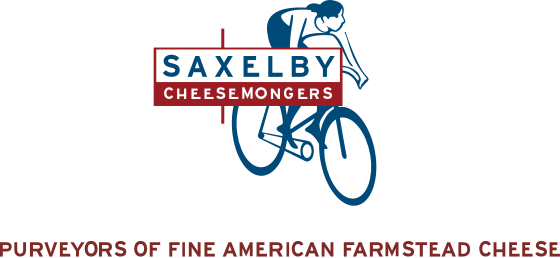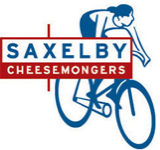
What makes a blue cheese a blue, and why is it blue in the first place? Welcome to Ask a Cheesemonger, where Jill Tardiff, the manager and specialty foods and beverage buyer of our Chelsea Market shop, answers all your burning questions about cheese.
Hi Jill! Could you tell us what makes a cheese a blue cheese?
Blue cheeses are typically soft or semisoft with a crumbly to creamy texture. Their characteristic blue interior veining comes from culturing the milk with a fungus called Penicillium roqueforti.
Once molded, the cheeses are pierced with a needle. It's important to have some oxygen to encourage the veins to form. How you handle the curd and the piercing determines the texture and how the cheese tacks together. Some cheesemakers want a denser blue cheese so they'll hold the piercing until the curd has had time to come together; others who want a younger cheese will pierce early to quicken the process. What distinguishes one cheese from another is the kind of milk, its quality, and the characteristic blue "bite."

Where should I start tasting?
At our shop I'll ask people, "do you like Roquefort, Stilton, or Gorgonzola?” Those are the touch points that most people are familiar with, along with Danish Blue, so we can go from there. We can’t provide samples now because of covid restrictions, but when we can, I guide people in that order so they start with less pungent cheeses and work their way up.
If you like Roquefort, which is tangy and crumbly, I suggest something like Ewe's Blue from the Old Chatham Creamery. It's made of sheep's milk like Roquefort and has a melt in your mouth texture. Stilton tends to be dense; Bayley Hazen Blue from the Cellars at Jasper Hill Farm has a similar fudgy texture. If you like Gorgonzola Dulce, which is softer and sweeter, I often suggest Kind of Blue from Woodcock Farm Cheese Company in Vermont. Gorgonzola Piccante is a stronger cheese, so I recommend Middlebury Blue, a raw cow’s milk cheese from Blue Ledge Farm, also in Vermont.
I also ask what kinds of flavors and textures you're looking for. If someone wants a creamy mouthfeel, we might suggest a sheep's milk cheese; if they want something more mineral then we'd steer them towards goat's milk. You can also combine milks! We have a cheese from Hook's Cheese Company called Ewe Calf to Be Kidding that gets a tang from the goat milk, solidity from the cow, and a roundness from the sheep.

What if I can't get past that blue cheese smell?
If smell is a major obstacle, do the hold-your-nose trick while you taste. More often than not, your nose may tell you a cheese is stinky, but your tastebuds will say something different. In general, the most off-putting smell in cheese is ammonia that forms when cut cheeses have been wrapped for a long time. As cheesemongers it's our responsibility to make sure our cheeses are cared for until they're passed on to you. That's why we don't cut a cheese until it's ready to be sold. If you're storing blue cheese at home you can wrap it in cheese paper, wax paper, or aluminum foil; plastic will encourage that ammonia odor.
What ingredients does blue cheese pair with?
So many fruits: apples, cherries, figs, pears, and pineapple, as well as dried fruits like apricots, cranberries, dates, and raisins. Crisp vegetables like celery, cucumber, and carrot can cut the richness, while acidic herbs and greens such as chervil and watercress add balance. Most nuts, honey, and preserves go well with blue cheese, especially strongly flavored and spiced preserves like chutneys.
There are ingredients in some recipes that can turn you into a blue cheese lover, like caramelized onion, bacon, or shrimp. Focaccia topped with caramelized onion, blue cheese, and pear is common for good reason. Think about acid, too, such as in salad dressing: lemon and red wine vinegar are good choices.

When you’re pairing with drinks, remember the adage, “the stronger the cheese, the stronger the wine.” Traditionally, Sauternes and fortified wines like Tawny Port, or "big reds" are the go-to. Sparkling wines and sweet rieslings depending on the blue cheese. Certain IPAs, brown and red ales, stouts with residual sweetness, porters and lambics, as well as whiskeys and bourbons should not be overlooked. Then there's ice cider. A smoky black tea, a medium-to-full body coffee, and hot chocolate for that matter are excellent non-alcoholic options.
You also want to consider the cheese itself and how you’re serving it. Is the cheese made from cow’s milk or mixed with sheep or goat? Is it creamy or crumbly? Are you eating it as an appetizer or dessert?
What are good blue cheeses to cook with?
I most always recommend Hook's Blue from Hook's Cheese Company in Wisconsin. It’s a pasteurized cow’s milk Danish Blue-style cheese. With its semi-soft paste and rich, fruity, peppery notes, it’s easy to work into recipes from dressings to burgers and then some. It is a win-win choice with a good price point too.
Another recommendation is Dunbarton Blue from Roelli Cheese Haus, also in Wisconsin. It’s an English-style cheddar enhanced with blue veining that combines the best of two worlds.

Can you tell us your personal favorites?
That Ewe Calf to Be Kidding has just the right amount of tanginess at the front and smoothness at the finish that make it a terrific gateway cheese for customers who haven’t tried blue cheese before, or who don’t usually care for the style.
Mad River Blue from the von Trapp Farmstead is dense and fudgy with overtones of black licorice, mushrooms, and chocolate while offering a mild blue bite. I’ll admit it’s always a delight to tell the story of the von Trapp family while cutting a wedge, including their success with opening a brewery.
I also enjoy Cayuga Blue, an aged goat’s milk cheese from the Finger Lakes region—an area known for its underlying bedrock of limestone, sandstone, and shale. The cheese ranges from supple and creamy to flaky and firm with a distinctive minerality. An example of terroir at its best.
Visit Jill at our Chelsea Market cheese shop, and dive into all our blue cheeses!

